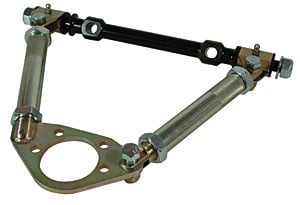I purchased poly for the pivots on the front of my car. When we started to take it apart, I was a little surprised to find the front suspension would not freely articulate with the shocks removed. The spindle and rotor weigh 35lb and I had to force it into the bump limit. Released, it would not drop further than half way and this was after letting it sit all night. I assumed it was because of the use of rubber in the joints.
We installed the poly bushings in the lower arms only, torqued the bolts to spec, and the arms were bound such that they would not drop with a 16 lb weight on the arm. After just a few cycles one the the bushing flanges was severely deformed and had been cut thru - hmm.
I ordered a new set of bushings and we went to work on what was causing the binding. The first thing we did was to pull the bushings and cut the flanges off of them. We reinstalled them into the the control arm tubes and reinstalled the arms.

By cutting the flanges we could measure the gaps between the bushing tubes and the pivot mounts. With the flanges removed I rotated the lower arms and noticed the tube ends were not vertically parallel to the pivot mounts. I had the faces squared on a mill and we reinstalled. Things rotated squarely and freely until we torqued them - still way too tight.
I found specs from the bushing manufacturer that stated the control arm bushing tubes need to be 1.480 long. The tubes on the arms measured 1.520. I had the tubes milled down to 1.490 and we reinstalled. Still the arms would not allow 13lb to drop.
We ordered a piece of 5/8 drill rod and slid it thru the pivot mounts and neither side would accept the rod.




I was a little startled by this at first because I was not sure where datum was. The good thing is the rod contacted at different points on the back pivot mounts. We grabbed a tape and the rods were both parallel to each other and parallel to the ground so we went with the front cross member being datum. We used a die grinder and opened the holes in the rear pivot points to allow the rod to slide thru. We welded in new locating washers on the rear pivot mounts. The rod now cleanly slid thru the pivot mounts.
We ordered another rod and checked the alignment of the control arm tubes and it became apparent why the ends were not parallel to the pivot mounts. The rod would not pass thru the arm tubes - hmm.
We cut three sides of the weld that attaches the tube to the arm, heated the remaining weld with a torch, and rotated the tubes parallel to the welding table until the rod would pass thru the tubes, then welded it all back together. We put the arms back on the mill and took the tube lengths down to 1.480 assuring the ends were parallel and vertical.
I have always liked Prothane bushings because they mold grease grooves in to the I.D. of the bushing. Prothane does not publish any dimensional data on their bushings so I went with Energy Suspension. To achieve the same thing, we milled 6 shallow longitudinal grooves into the bushing sleeves. We installed zircs in the top of the tubes. Side note - the bushing sleeves supplied with the bushings fit the pockets nearly perfect - no more than .020 clearance.
We put it all back together and it will barely hold a 6lb weight. Once it begins to drop, it is straight thru. There is an ever slight amount of static friction I believe between the bushing flanges and the pivot mounts, but it is nothing in the big picture and most likely will wear in.
We are replacing the top arms with some adjustables from Specialty Products

They come with hard bushings, zircs, and swing very freely.
We reassembled with just spindle and the assembly lifts very easily and falls very quickly.



